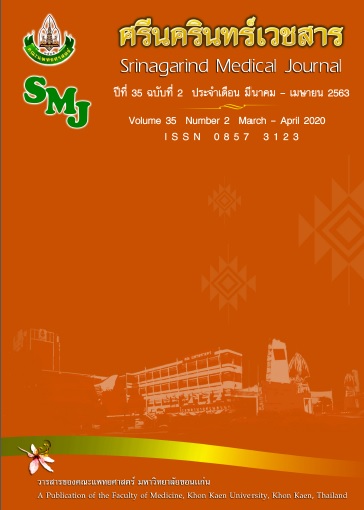อุบัติการณ์และปัจจัยทำนายภาวะสับสนเฉียบพลันในผู้สูงอายุหลังผ่าตัด
คำสำคัญ:
อุบัติการณ์; ปัจจัยทำนาย; ภาวะสับสนเฉียบพลัน; ผู้สูงอายุที่ได้รับการผ่าตัดบทคัดย่อ
หลักการและวัตถุประสงค์ : ภาวะสับสนเฉียบพลันเป็นกลุ่มอาการที่พบได้บ่อยในผู้สูงอายุที่เข้ารับการรักษาด้วยการผ่าตัด เมื่อเกิดภาวะนี้จะมีผลกระทบต่อตัวผู้สูงอายุ ผู้ดูแล และระบบบริการสุขภาพ การวิจัยนี้มีวัตถุประสงค์เพื่อศึกษาอุบัติการณ์ และปัจจัยทำนายภาวะสับสนเฉียบพลันในผู้สูงอายุหลังผ่าตัดที่เข้ารับการรักษาในหอผู้ป่วยศัลยกรรม
วิธีการศึกษา : การศึกษาครั้งนี้เป็นการศึกษาแบบย้อนหลัง (Retrospective study) ประชากรที่ศึกษาคือผู้ที่มีอายุตั้งแต่ 60 ปีขึ้นไป เข้ารับการรักษาโดยการผ่าตัด ในหอผู้ป่วยศัลยกรรม โรงพยาบาลศรีนครินทร์ คณะแพทยศาสตร์ มหาวิทยาลัยขอนแก่น จำนวน 522 ราย ช่วงระหว่างเดือนมกราคม 2556 – ธันวาคม 2558เก็บข้อมูลด้วย แบบบันทึกข้อมูลส่วนบุคคลและประวัติการเจ็บป่วย บันทึกทางการแพทย์และบันทึกทางการพยาบาล แบบประเมิน Thai version of Confusion Assessment Method: CAM-algorithm แบบเก็บข้อมูลปัจจัยที่มีผลต่อการเกิดภาวะสับสนเฉียบพลันที่ผู้วิจัยสร้างขึ้น มีค่าสัมประสิทธิ์ความเชื่อมั่นเท่ากับ 0.83 วิเคราะห์ข้อมูลโดยใช้โปรแกรมคอมพิวเตอร์สำเร็จรูป SPSS/PCใช้สถิติเชิงบรรยายในการวิเคราะห์ข้อมูลส่วนบุคคล วิเคราะห์ความสัมพันธ์ของปัจจัยที่ศึกษาโดยใช้สถิติสัมประสิทธิ์สหสัมพันธ์เพียร์สัน วิเคราะห์ปัจจัยทำนายด้วยการวิเคราะห์ถดถอยพหุคูณแบบขั้นตอน กำหนดระดับนัยสำคัญทางสถิติที่ระดับ p≤0.05
ผลการศึกษา : พบว่า อุบัติการณ์การเกิดภาวะสับสนเฉียบพลันในผู้สูงอายุหลังการผ่าตัด พบร้อยละ 4.78 จาก 522 ราย พบ 25 ราย มีตัวแปร การเสียเลือดมากกว่า 900 ซีซี ระยะเวลาในการผ่าตัดมากกว่า 300 นาที การได้รับเลือด/สารน้ำมากกว่า 300 ซีซี ชนิดการดมยาสลบแบบ GA (General Anastasia) และระดับความปวดหลังผ่าตัด 24 ชั่วโมงระดับ 8-10 คะแนน ที่ร่วมกันทำนายการเกิดภาวะสับสนเฉียบพลันในผู้สูงอายุหลังผ่าตัดได้อย่างมีนัยสำคัญทางสถิติ (p < 0.001) ซึ่งตัวแปรทั้ง 5 ตัวสามารถอธิบายการผันแปรการเกิดภาวะสับสนเฉียบพลันในผู้สูงอายุหลังผ่าตัดได้ร้อยละ 14 (R2=.140 )
สรุป : การเกิดภาวะสับสนเฉียบพลันในผู้สูงอายุหลังผ่าตัดร้อยละ 4.78 ปัจจัยที่ร่วมทำนายการเกิดได้แก่ การเสียเลือดมากกว่า 900 ซีซี การได้รับเลือด/สารน้ำมากกว่า 300 ซีซี การดมยาสลบแบบ GA ระยะเวลาการผ่าตัดมากกว่า 300 นาที ระดับความปวดระดับรุนแรงหลังผ่าตัด 24 ชั่วโมงร้อยละ 14 ทั้งนี้ควรมีการศึกษาเพื่อค้นหาสาเหตุและปัจจัยอื่นๆเพิ่มเติม
เอกสารอ้างอิง
2. Inouye SK, Charpentier PA. Precipitating factors for delirium in hospitalized elderly persons. Predictive model and interrelationship with baseline vulnerability. JAMA 1996; 275: 852-7.
3. กอบแก้ว ทองติด. ภาวะสับสนฉับพลันในผู้สูงอายุหลังผ่าตัด. วิทยานิพนธ์พยาบาลศาสตรมหาบัณฑิต สาขาวิชาการพยาบาลผู้สูงอายุ คณะพยาบาลศาสตร์ มหาวิทยาลัยขอนแก่น, 2553.
4. 4. ประเสริฐ อัสสันตชัย. เมื่อผู้สูงอายุต้องรับการผ่าตัด. สารศิริราช 2003; 55: 607-19.
5. American Psychiatric Association. Diagnostic and statistical manual of mental disorders, 4th Edition, text revision. Washington DC, 2000.
6. Eden BM, Foreman MD. Problems associated with under recognition of delirium in critical care: a case study. Heart Lung 1996; 25: 388-400.
7. Marcantonio ER, Kiely DK, Simon SE, John Orav E, Jones RN, Murphy KM, et al. Outcomes of older people admitted to postacute facilities with delirium. J Am Geriatr Soc 2005; 53: 963.
8. Truman B, Ely EW. Monitoring delirium in critically: using the confusion assessment method for the intensive care unit. Crit Care Nurse 2003; 23: 25-36.
9. Clark B Halm MA. Post procedural acute confusion in the elderly. ANJ 2003; 3: 64UU-64EE.
10. Dupplis GS. Delirium during hospitalization: incidence, risk factors, early sign and patient’s experience of being delirium. Sweden: Acta University Upsaliensis, 2003.
11. Ganai S, Lee KF, Merrill A, Lee MH, Bellantonio S, Brennan M, et al. Adverse outcomes of geriatric patients undergoing abdominal surgery who are at high risk for delirium. Arch Surg 2007; 142: 1072-8.
12. Kazmierski J, Kowman M, Banach M, Fendler W, Okonski P, Banys A, et al. Incidence and predictors of delirium after cardiac surgery: Results from The IPDACS Study. J Psychosom Res 2010; 69: 179-85.
13. ณหทัย วงศ์ปการันย์. ความแม่นยำและความน่าเชื่อถือของแบบประเมิน Confusion Assessment Method for the Intensive Care Unit (CAM-ICU) ฉบับภาษาไทย: มหาวิทยาลัยเชียงใหม่, 2554.
14. Inouye SK, van Dyck CH, Alessi CA, Balkin S, Siegal AP, Horwitz RI. Clarifying confusion: The Confusion Assessment Method. A new method for detecting delirium. Ann Intern Med 1990; 113: 941-8.
15. Yamagata K, Onizawa K, Yusa H, Wakatsuki T, Yanagawa T, Yoshida H. Risk factors for postoperative delirium in patients undergoing head and neck cancer surgery. Int J Oral Maxillofac Surg 2005; 34: 33-6.
16. Miller CA. Chapter 24 Impair cognitive function: delirium and dementia. In: Nursing for Wellness in older adult: Theory and Practice. 4th. Ed. Philadelphia: Lippincott Williams& Wilkins, 2004.
17. กชพนิต ขันตีจิตร , สายพิณ เกษมกิจวัฒนา และ ปรางทิพย์ ฉายพุทธ. การพัฒนาแนวปฏิบัติการพยาบาลในการป้องกันการเกิดภาวะสับสนเฉียบพลันในผู้สูงอายุที่ได้รับการผ่าตัดในระบบทางเดินอาหาร. วารสารสภาการพยาบาล 2551; 23: 26-37.
18. อรพินธ์ สีขาว. ภาวะสับสนอย่างเฉียบพลัน : มุมมองใหม่ในการป้องกันดูแล. วารสาร มฉก.วิชาการ 2546; 7: 91-101.
19. Inouye SK. Current concepts: delirium in older people. England J Med 2006; 354: 1157-65.




